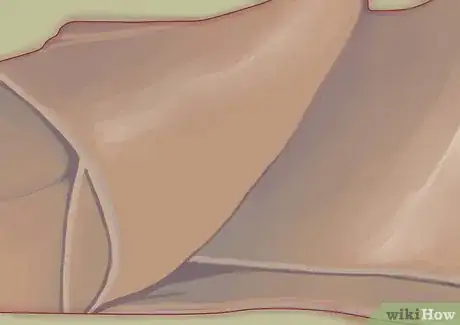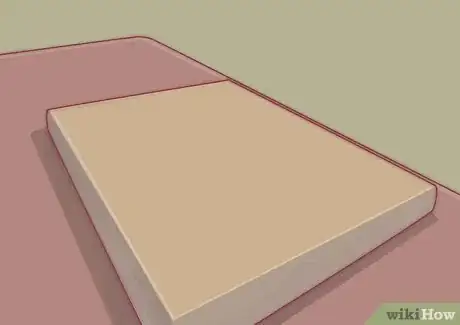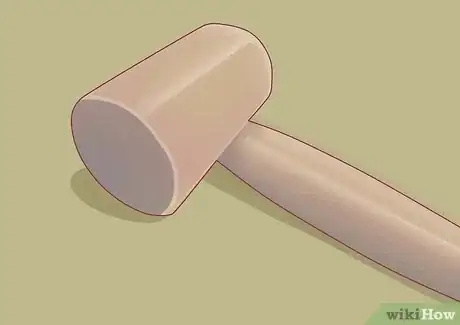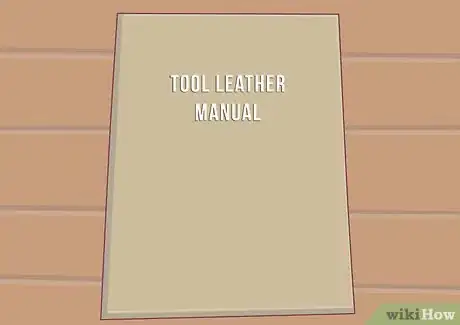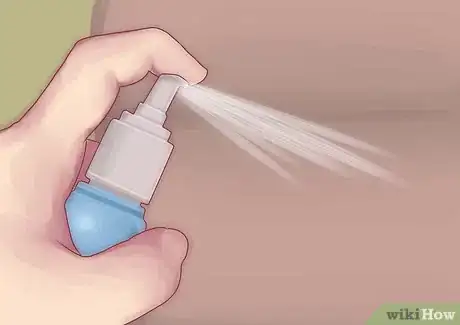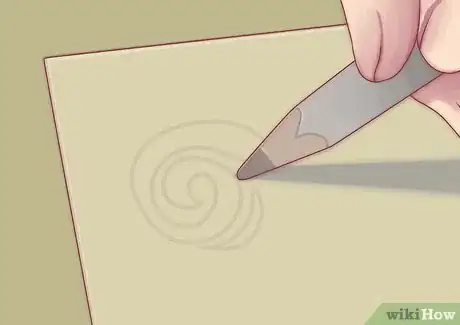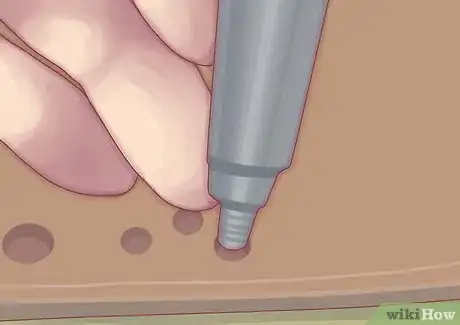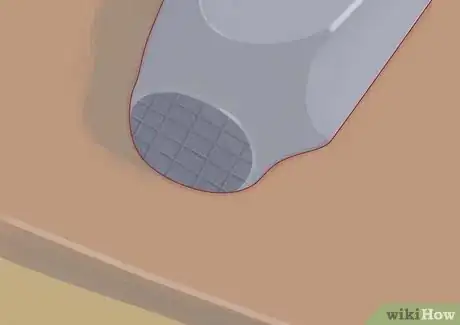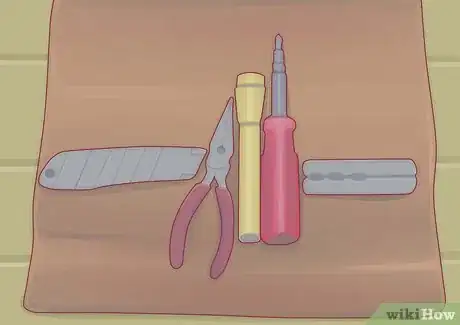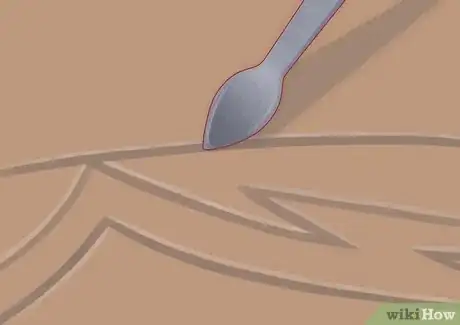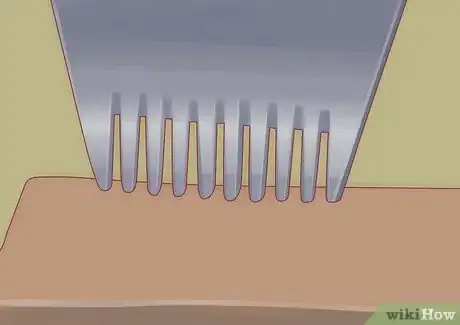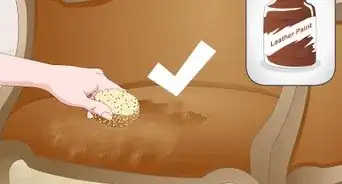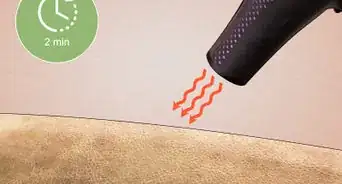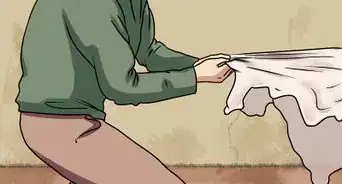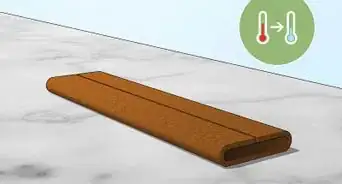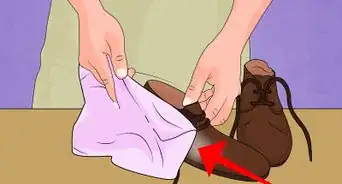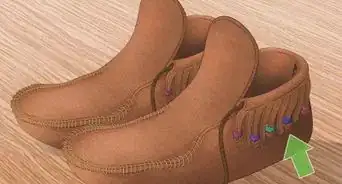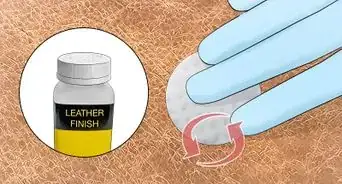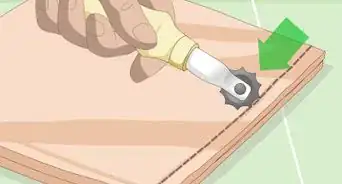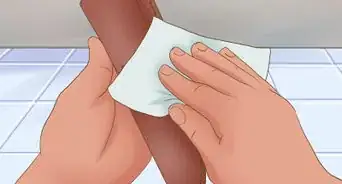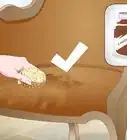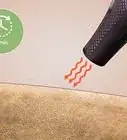wikiHow is a “wiki,” similar to Wikipedia, which means that many of our articles are co-written by multiple authors. To create this article, 23 people, some anonymous, worked to edit and improve it over time.
wikiHow marks an article as reader-approved once it receives enough positive feedback. In this case, 95% of readers who voted found the article helpful, earning it our reader-approved status.
This article has been viewed 249,392 times.
Learn more...
Whether you're making a beautiful horse saddle for yourself or a custom belt for your boyfriend, tooling leather is a great craft that can be picked up by even the least crafty among us. Tooling leather is the process of cutting into the leather to create shapes and designs. There are other leather crafting processes that often go hand-in-hand with tooling, however, such as leather stamping. If you're new to the leather world, this article will show you how to do all of the basics and get a beautiful finished product.
Steps
Choosing and Buying Leather
-
1Find a good place to buy leather. Common places to buy leather include Tandy Leather Factory and Springfield Leather Company. You can find physical stores in your area but there are also a number of online retailers. Of course, if you find another option that you like better, you can take that option.
-
2Understand how good leather is sold. When looking at places to buy leather, you should look at how they are selling it. Good leather is usually bought by the square foot or by the piece. You can also buy scrap leather by the bag. If someone's selling you leather that doesn't seem right, be wary.Advertisement
-
3Look out for scars, bug bites, and brands. Not only will scars, brands, and bites make your final product difficult to tool and look bad,[1] they're also a sign that a leather vendor is supplying their leather from places that treat their cows terribly. You don't want to have any part in animals being abused, so buy your leather from good sources.
-
4Start by buying cheap, beginner's leather. It is said that writers need to write a few hundred thousand words before any of the words are good. For leather working, you're going to have to do some bad work before you're ready to start doing good work, so you should not start by buying fancy leather. Buy scrap leather by the bag or any other cheap beginner's leather. You'll know when you're ready for something a little nicer!
-
5Buy the right type of leather for tooling. For tooling, cow leather that has been vegetable tanned is the best option. Other leathers can be used for other details, but cow veg tan is your friend when it comes to tooling.
- You will want to avoid leather that is intended for furniture and leather that is textured. These are not suitable for tooling.
-
6Choose the appropriate thickness for your project. Different projects will need leathers of different thicknesses. Make sure you're getting the right thickness for what you want to do. Leather thickness is measured by the ounce. For tooling, 2-3 ounces is too thin. Start instead with 3-4 ounces and use thicker leather depending on your purposes.
- Weights translate to a standard range of millimeters. You may want to test the thickness of your leather pieces when you buy a new batch to make sure that you got what you paid for.
Choosing and Using Tools
-
1Buy a starter tool set. There's no reason to go straight into professional, expensive tools. In fact: it's best to start off with a beginners set because everyone tools differently and what works for someone else may not work for you. You want to be able to experiment. Good starter sets can be bought at very reasonable prices from stores like Tandy, both online and locally.
-
2Consider some modeling tools. Modeling tools, while technically designed for clay, can be extremely useful for leather crafting as well. Tools like a stylus are commonly used, as are tools like a modeling spoon.
-
3Get a cutting board. You should never cut your leather on scrap wood or any surface with a texture (and of course you don't want to cut on a surface you want to preserve), because the texture can be transferred to the leather and even make the leather more difficult to cut. You want to use a marble or granite cutting board. These can be purchased or you can ask a local contractor or granite supply company for scrap.
- A rubber mat underneath can dim some of the sound and keep your cutting board in place.
-
4Get a mallet. A mallet is a universal tool that you will need for doing almost any style of tooling. You want to to use a poly mallet when you start learning to work with leather. Never use a metal mallet and avoid wood mallets (as they are delicate). Rawhide mallets are good but expensive, so if you want to experiment with these, wait until later.
-
5Focus on the most important tools. If you have to buy tools individually, focus on buying the most basic, most useful tools. A stylus, a swivel knife, a modeling spoon, a beveler, a mallet, and a few basic stamps (often also called single-action tools) will get you through learning the craft.
-
6Check to be sure that your tools are the best size for you. Tools come in a number of sizes and the standard sizes are usually for large, male hands. If you are younger or generally have smaller hands, getting smaller sized tools will make the tool significantly easier to use.
-
7Understand the language of leather designs. Stamps and the traditional shapes of leather working tools almost have a unique language unto themselves. Most of the tools will have names that do not seem to make sense, but almost all of them refer to the traditional cowboy leather designs and the specific purpose those tools were meant to serve. Learning the names for the tools can be extremely useful, especially for understanding instructions that you find online and for finding the tools you need.
-
8Don't feel constrained to standard usages. Tooling leather is just like traditional sculpting: there are lots of tools and everyone uses them in slightly different ways. You should not feel like just because you use a stamp to get one look when it's really for getting another, that you're somehow wrong. Whatever works for you and looks good is fine.
Creating Your Piece
-
1Print your pattern. The easiest and cheapest way to make your pattern is to simply print it out at home on normal printer paper. You can also trace the design onto wax or tracing paper. However, you should never use carbon paper or draw a design directly onto the leather.
- This is an optional step, as you can do your leather tooling freehand or by creating your own pattern.
-
2Cut out your piece. Cut the leather into the size and shape of the final piece (a belt if you're making a belt, the side of a saddle, the long rectangle of a wallet, etc). Do not ever use scissors to cut this type of leather however. Scissors are only suitable for very thin, fabric-like leather. You should instead use a box cutter or x-acto knife.
-
3Case the leather. Casing leather is just a fancy word for getting it wet, but that doesn't mean you should go straight for some water. Water is perfectly usable but a casing solution (which you can buy from leather stores and online) will help protect your leather from water stains. Just apply your liquid of choice over the surface area that you'll be working with, using a spray bottle or sponge.[2]
- You don't want to soak or over-wet the leather, however. Apply the liquid in moderation.
- Generally you don't want to case a single area more than once. If you need to stop working for awhile, wrap the leather in plastic wrap and put it in the fridge.
-
4Trace your design onto the leather. Wait until the leather starts to turn back to its original color and then start tracing your design. Simply align your pattern and then use a dull pencil or modeling stylus to "draw" over the design on the paper. You should not press hard. Lift up the paper and you will see that the casing allows the light pressure of your drawing to transfer the design temporarily onto the leather.[3]
-
5Cut your main lines into the leather using a swivel knife. With this temporary outline, you will want to cut the main lines of the design onto the leather. Hold the swivel knife like a pen you're clicking down the end of, with your pointer finger in the saddle and your thumb and middle finger on the barrel. Hold it so that the blade is straight up and down and place the back corner into the leather. Then, pull the blade towards you. Keep your wrist straight and turn the blade as necessary by moving your fingers on the barrel.[4]
- The blade should always be pulled towards you, so you will have to adjust your leather accordingly.
- It is a good idea to spend a lot of time practicing with the swivel knife on scrap leather before starting a serious project. This will help you learn how to move the blade to get the look you want.
- You can change the speed, pressure, and length of the stroke to get different looks. For example, a quick, short pull can create a whisker look.
-
6Decide which areas will need to be raised or lowered. With your main lines cut into the leather, you'll want to decide which areas should be lower and which should be raised. You'll also want to think about which areas will need shading or texture. Planning this out ahead of time and mapping it on your sketch can be useful in creating a professional final look.
-
7Bevel or emboss the edges to make your design pop. You can use tools like the modeling spoon to press down the edges on one side of the design or the other, in order to make it look raised or make it look embedded. Just make sure to stay consistent which which areas get raised or lowered!
-
8Use your stamps to create designs and add shading or texture. Now you can pull out your stamps! Place a stamping tool against your leather, so it is standing up vertically but resting evenly on the leather. Tap or double-tap the mallet down vertically against the top of the leather tool to imprint the design. Begin by using a scrap piece of leather until you realize how much pressure you must exert.
- The mallet should not be slammed down on the tool. When you use a stamp, the impression should not break the surface of the leather and create "walls" allowing you to see the sides. The tool should also be held loosely, so that it can bounce back up after being tapped.
- In your practice, aim to stamp the leather only once per placement on the leather. Some larger stamps may require two or more strikes of the mallet. In this case, line the stamp up again with the imprints you have already made and strike it again.
-
9Weigh the leather down as necessary. Tooling, especially tooling large areas on leather, will make the leather warp. An easy way to combat warping is to weigh the piece down when you are done so that it dries in the appropriate shape. You don't need to use anything too heavy and be careful of placing anything with a texture onto the wet leather.
Adding Finishing Touches
-
1Bevel the edges of your leather. Use a bevel tool to cut the square off of the edge of your leather. This will keep the edges from rolling up over time. It is only necessary to bevel one side of the leather: the back side can remain flat. Pay special attention to any sharp corners on your leather piece. These will need to be beveled separately, creating a diagonal or cut corner.
-
2Add finishes, dyes, or paint. With your edges beveled, you can move on to adding whatever finish is appropriate for your leather. You can use a resist to keep it a particular area clear of the finish or to reduce the coloring. Just be sure to always use gloves when using dyes or finishes....unless you like your hands a different color!
- Tandy sells excellent finishes in a variety of colors. To apply these, use a paper towel, wool dauber, or a natural or very old sponge (regular sponges contain a chemical that does not react well with the leather).
- You can also use dyes. There are dyes intended for leather, but some leathers can also be dyed with shoe polish! These should be applied in the same way as the finishes.
- Acrylic paint thinned with water works on leather, if you'd prefer a painted look. Just use a normal paint brush to apply it. This works better for smaller, detailed sections than larger ones.
-
3Smooth the edges. You'll want to smooth the beveled edges of your piece after dying it. You can use a special tool for this purpose but the cheaper option is to simply rub it with a paper towel or canvas cloth! This will make the edges look shiny and professional.
-
4Punch holes for stitching. If you plan on doing any stitching, you'll want to add a stitching groove to keep your stitches from being worn down over time. There is a tool for this purpose called a stitch groover. Once you've cut a channel into your leather where the stitching will go, use a pricking iron or overstitch wheel to lightly mark where your individual stitches will go. This will help create an even, professional look. Finally, punch the individual holes you marked using a piercing awl.
- When buying an overstitch wheel or pricking iron, get a shorter one to start off with, as it will be more versatile and make it easier to turn corners.
- When starting a new stitching line or having to otherwise pick up the overstitch wheel to start again, place the first spoke down in the hole of the last section of the line. This will keep the stitches even.
-
5Add other details. Before sewing, you'll want to add any other finishing touches that you know you'll need, like adding snaps. Be aware, however, that adding things like snaps is difficult and requires its own separate set of tools. Once that's done, add your stitching and you're basically done. Rub the whole surface with a cloth to get a nice, smooth final look.
-
6Add a clear finish if desired. As a final measure, you can add a clear final finish on after doing your stitching, if you want to. This is not necessary, however. Enjoy your new creation and don't forget to keep practicing!
Community Q&A
-
QuestionCan I use leather in soft leather off cuts?
 Community AnswerYes, it can be used for in many ways, like patch ups, shoes, purses and more.
Community AnswerYes, it can be used for in many ways, like patch ups, shoes, purses and more. -
QuestionWhat is the device called to emboss words on leather?
 MmckirahanCommunity AnswerTools known as "embossers" basically consist of a single wheel at the end. When rolled across a section of leather (with appropriate downward pressure), you're able to transfer whatever three-dimensional imagery or letters are inscribed on the wheel. That said, other techniques exist as well, including leather "stamps" (where a wooden or rawhide mallet is used to strike a metal rod down onto a piece of leather), as well as "pyrography", which involves the use of a high-temperature, handheld device (similar in appearance to a common soldering iron) to carefully "draw" (or more accurately, "burn") letters or images into the leather.
MmckirahanCommunity AnswerTools known as "embossers" basically consist of a single wheel at the end. When rolled across a section of leather (with appropriate downward pressure), you're able to transfer whatever three-dimensional imagery or letters are inscribed on the wheel. That said, other techniques exist as well, including leather "stamps" (where a wooden or rawhide mallet is used to strike a metal rod down onto a piece of leather), as well as "pyrography", which involves the use of a high-temperature, handheld device (similar in appearance to a common soldering iron) to carefully "draw" (or more accurately, "burn") letters or images into the leather.
Warnings
- Do not use a metal mallet when tooling leather. It will apply too much pressure. A poly or rawhide mallet will exert the right amount of pressure against the tool.⧼thumbs_response⧽
Things You'll Need
- Scrap cow veg tan leather
- Poly mallet
- Single-action tools or stamps
- Piercing awl
- Water or casing solution
- Natural sponge
- Granite cutting slab
- Stylus
- Swivel knife
References
About This Article
To tool leather, start by cutting out your piece of leather using a box cutter. Then, spray the leather with some water or a casing solution so it's wet but not soaked. Next, place your printed-out design on the leather and go over it with a dull pencil or stylus to transfer the design. Once you can see your design on the leather, cut out the main lines of it using a swivel knife. Finally, go back in and add the finishing touches to your design. To learn how to use leather stamps to enhance your design, scroll down!


